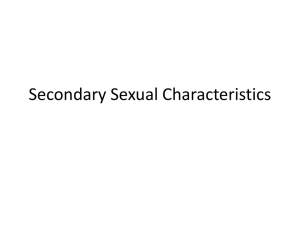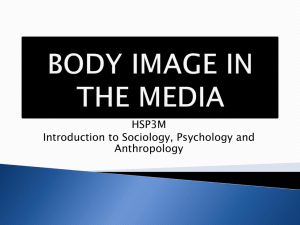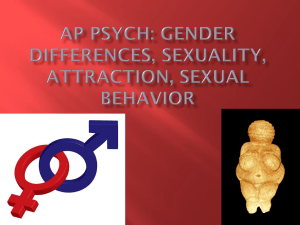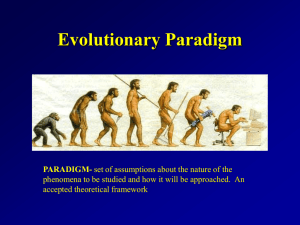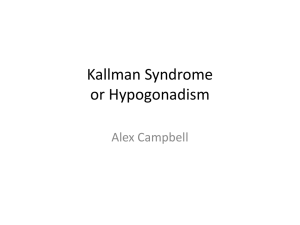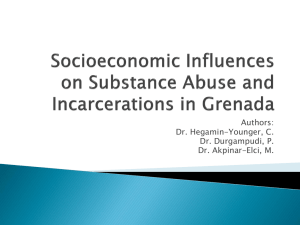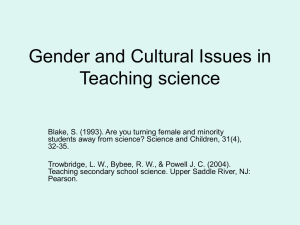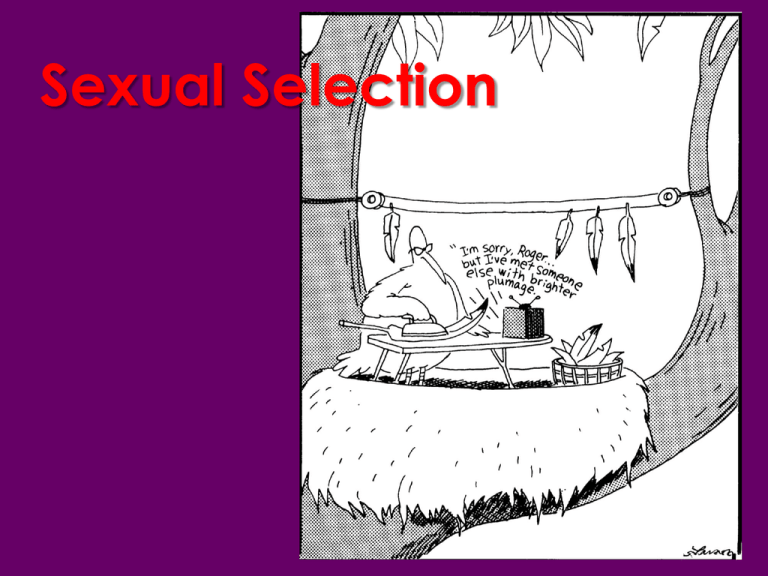
Sexual Selection
Evolutionary Mechanisms
Genetic Drift
Migration
Non-adaptive
Mutations
Natural Selection
Adaptive
Natural
Selection
OUTLINE
(1) Sexual Selection
(2) Constraints on Natural Selection
Pleiotropy
Evolutionary Tradeoffs
Genetic Drift and Natural Selection
Male
Female
Male
Female
Male
Female
Theory of Sexual
Selection
The sex bearing a higher cost to reproduction or
has higher parental investment will generally be
the chooser (has more to lose from bad choice)
Whereas the sex bearing the lesser cost of
reproduction or parental investment generally
competes more heavily for mates (Bateman 1948)
Asymmetric Limits on Fitness
• The sex that has higher reproductive cost
will be the choosers
• If you’re allocating a lot of resources toward
offspring and are limited in the number of
offspring you can have, you won’t mate with
just anyone
• The sex that are being selected (under
sexual selection) will be competitive
• Fight with each other, fight for resources, fight
for access to or control of females
Theory of Sexual Selection
In sexual species, it is almost always males who invest less
in each offspring it is typical for males to compete for
access to females
In 90% of mammal species, females provide substantial
parental care, while males provide little or none
(Woodroffe and Vincent 1994)
And as a consequence, it is males of many species that are
typically larger and have brighter coloration than the
females (Andersson 1996 - also book: Sexual Selection by
Andersson)
Sexual selection leads to sexual dimorphism
Example of Sexual Selection in Humans
Height is a
sexually selected
trait in humans
Example of Sexual Selection in Humans
Over the last several million years, hominids
have been getting taller (including Homo
sapiens sapiens)
There is evidence that sexual selection
favors greater stature in human
males(Pawlowski et al. 2000. Nature; Husain &
Firdous 1990; Meuller & Mazer 2001)
Example of Sexual Selection in Humans
In humans, females prefer taller men
(Husain & Firdous 1990)
In humans, taller males have greater fitness
(Pawlowski et al. 2000, Nature; Meuller & Mazer 2001)
In a study by Pawlowski et al. 2000, based on 3,201
healthy men aged 25–60, childless men were
significantly shorter than those who have at least one
child
Example of Sexual Selection in Humans
BUT, there are often constraints on selection
In the case of selection on human height,
antagonistic pleiotropy might be a factor
Some evidence that shorter females on average
have greater life time reproduction (reach maturity
sooner)
So there might be conflicting forces affecting the
evolution of human height (Evolutionary Tradeoffs)
Asymmetry of Sex
Expensive egg, cheap sperm
Females limited by cost of reproduction, little
variation in mating success
Males limited by ability to find mates, and
have a greater variance in male reproduction
Sexual selection tends to act more heavily on
males, dictated by female choice
Males have much higher
variance in mating success and
offspring number than females
Most females mated
two or three times,
whereas majority of
males never mated; a
few males had 300
offspring or more
Males are more limited by number of mates and their
reproductive success depends more heavily on their
ability to mate than for females
Asymmetry of Sex
Higher mutation rate in male germ line
In many species, greater sexual selection of
males (driven by female choice)
Is Male-driven Evolution common?
Asymmetric Limits on Fitness
When Females are the sex with higher
reproductive cost
• Male reproductive success is limited by access to
mates (which is correlated with reproductive
success)
• In contrast, female reproductive success is
limited by the cost of making eggs or the cost of
parental care
Most extreme genetically-documented
case of skew in reproductive success in
humans
Genealogy based on Y-chromosome:
paternally inherited, male line
Survey of 16 populations throughout Asia
found that 8% of men carry an unusual Ychromosome that originated in Mongolia
~1000 years ago.
The lineage is carried by
likely male-line descendants
of Genghis Khan
Zerjal, et. al. 2003. The Genetic Legacy
of the Mongols. American Journal of
Human Genetics, 72: 717-721.
Genghis Khan
Typically sexual selection acts on males. However,
when males provide greater allocation toward parental
care than females, the pattern can be reversed
In sharp contrast to the previous
example, in the broad-nosed pipefish,
the males provide all the parental care
In this case, females
showed greater
variance in
reproductive success
and were more limited
by mating success
In the broad-nosed pipefish, where males provide all the
parental care, FEMALE reproductive success depends
more heavily on their ability to mate than for males
Hypotheses on causes
of sexual selection
What exactly is the choosier sex choosing?
Good
genes (certain traits, symmetrydevelopmental stability)
Increased heterozygosity (e.g. MHC loci)
Access to resources (a good nest, food, etc.)
Good Genes Hypothesis:
A trait under selection that
is correlated with fitness
A male gray tree frog (Hyla versicolor)
Females prefer
male frogs that
call longer, and
such frogs
produce offspring
with higher
fitness
Sexual Selection for Heterozygosity
(a type of Balancing Selection)
Sexual Selection for
Heterozygosity at MHC loci
What is Major Histocompatibility
Complex (MHC)?
MHC is a series of genes (a large gene family) in vertebrates that
encode cell surface proteins which control the adaptive immune
response.
The function of these proteins is to present fragments of antigens
(degradation products from within the cell) to T cells. The
receptor of T cells can only recognize antigen fragments that are
complexed with MHC proteins.
Healthy cells will be ignored, while cells containing foreign
proteins (and then displayed by MHC proteins) will be
attacked by the immune system
Sexual Selection for
Heterozygosity at MHC loci
What is Major Histocompatibility
Complex (MHC)?
Schematic
representation
of MHC class I
The MHC shows a high degree of polymorphism (100 times
higher than the genome average)
Rapid evolution of MHC is associated with rapid evolutionary
response to diseases… MHC diversity can present wider range
of antigens on cell surface
MHC alleles determine organ donor compatibility. Defects in
certain MHC genes lead to autoimmune disorders in which the
body fails to recognize self-antigens. Examples include multiple
sclerosis, some forms of arthritis and diabetes
Why is it good to be heterozygous at MHC loci?
The amount of genetic diversity within the MHC
enables the immune system to recognize—and
process—a broader range of foreign antigens
and pathogens
The ability to process more antigens confers the
ability to stimulate an immune response
towards a wider range of antigens
More Heterozygous Have more MHC alleles
recognize a greater diversity of pathogens
Sexual Selection for
Heterozygosity at MHC loci
Major Histocompatibility Complex (MHC) influences
mating preferences and, in some cases, this may be
mediated by preferences based on body odor
Studies on rodents and fish, and several studies on
humans have reported a tendency to prefer MHCdissimilar mates
This is a sexual selection that would favor the
production of MHC-heterozygous offspring, who
would be more resistant to pathogens A type of
Balancing Selection favoring heterozygotes
The Sweaty T-shirt Experiment
(Wedekind et al. 1995)
Female and male students were
genotyped for their MHC alleles (HLA-A, -B
and –DR)
Each male student wore a T-shirt for two
consecutive nights.
Each female student was asked to rate the
odors of six T-shirts.
Results: Females scored male body odors
as more pleasant when the men differed
from them in their MHC alleles.
Also, odors of MHC-dissimilar men
reminded the test women more often of
their own actual or former mates than
odors of MHC-similar men.
The Sweaty T-shirt Experiment
(Wedekind et al. 1995)
Females who were not taking
oral contraceptives preferred
odors of males that were
dissimilar in MHC alleles
Females taking oral
contraceptives preferred odors
of MHC-similar males.
Communally nesting mice also
prefer MHC similar odors.
Oral contraceptives mimic the
physiological state of pregnancy
and interfere with natural
attraction
Selection for Heterozygosity at MHC
Additional studies:
Couples who failed to achieve pregnancy after two or more
attempts of in vitro fertilization (IVF) or tuba1 embryo transfer
(TET) shared a significantly greater number of HLA antigens
than did control couples who achieved viable pregnancy with
their first IVF or TET (Weckstein et al. 1991)
Couples who suffer from recurrent spontaneous abortions
often share a higher proportion of their MHC than control
couples (Beer et al. 1985; Bolis et al. 1985; Thomas et al. 1985; Karl et al.
1989; Ho et al. 1990; Koyama et al. 1991; Laitinen 1993).
Genome scans showed that European American couples were
significantly more MHC-dissimilar than random pairs of
individuals, and that this pattern of dissimilarity was extreme
when compared to the rest of the genome (Chaix et al. 2008)
Constraints on Natural Selection
Constraints on Natural Selection
Genetic Variation: Selection can only act on existing genetic
variation (we talked about this last lecture)
Phylogenetic Inertia (Historical Constraints): can only build on
what is there (hard to make wings without appendages)
Pleiotropy: one gene might affect more than one trait. So if
you alter a gene, it could have multiple effects. So you might not be
able to alter that gene
Evolutionary Trade-offs: there could be counteracting forces;
A favorable trait could incur costs on a different trait (increase in
fat to resist cold could lead to diabetes)
Genetic Drift will interfere with the action of Natural Selection
in small populations
Pleiotropy:
when a gene
affects many traits or functions
• Selection might not be able to
act on trait if the gene that
codes the trait is Pleiotropic,
and also affects other traits.
So, changing the gene could
negatively affect the other traits
Gene Network
• Conversely, a seemingly unbeneficial trait might get
selected for because the gene that codes for it also
enhances fitness
• Pleiotropy could sometimes lead to evolutionary tradeoffs
(you can have evolutionary tradeoffs that are not
pleiotropic– between traits encoded by different genes)
Hard to select on a gene that affects multiple traits
(pleiotropy)
Water retention might be good for desiccation
resistance, but also cause hypertension
High estrogen could increase fertility, but also increase
cancer (estrogen has many targets in the body, and
many consequences)
Some genes (“Thrifty genes”) are helpful in famines
but also lead to diabetes and obesity
(https://docs.google.com/viewer?a=v&q=cache:pgRlIhEJligJ:www2.uah.es/salud-yenfermedad/pdf/The%2520double%2520puzzle%2520of%2520diabetes.pdf+&hl=en&gl=us&p
id=bl&srcid=ADGEESgMnHzClSUTNI0ZGz690SR4DqSzAVrwRfKILLhBESRcADGmLWJZAUg0IKftVhXpxQumQ0Ox8zixtrylo9xmuZLG30zXRue2MXl3GB7XYwxxS0PQZjFlJaoZ6rAOqF0KSuEC5I&sig=AHIEtbT8VrWAgqBRyM46mdeCd3Ayce
mudQ)Ta
Other Examples of Evolutionary Trade-offs:
Selection on HIV virulence in response to
transmission rate - careful versus slow reverse
transcription rate
Sickle Cell Anemia - heterozygote resistance to
malaria vs lethality of the recessive homozygote
Degeneration during Aging - what might be beneficial
early in life could be harmful later (ageing)
What might be good in one environment could be
bad in another:
Pale
skin is helpful in Northern latitudes:
6x rate of Vitamin D synthesis relative to darker skin
While, Pale skin is harmful in Southern latitudes:
Natural Selection and Aging:
Evolutionary Trade-off between
early vs late life
Selection might favor alleles that
benefit early life stages even if
they are deleterious later in life.
Thus, deleterious traits
accumulate after reproduction.
Williams 1957: antagonistic pleiotropy
theory of aging
Or Not….
Trade-offs during Aging
If a trait is deleterious at a young age,
the individual will die before
reproducing
If it is harmful at an old age, it won’t
get selected out of the population (no
kids, nothing to select on)
Example: sex hormones; high
estrogen concentration at a young age
could enhance fertility, but increase
risk of cancer at an older age
Or Not….
Genetic Drift and Natural Selection
Because of the randomness introduced by
Genetic Drift, Natural Selection is less
efficient when there is genetic drift
Thus, Natural Selection is more efficient in
larger populations, and less effective in
smaller populations
Selection acts only on
genes that are expressed
Remember that selection acts on
the phenotype… the traits that are
expressed, given the genotype
Concepts
Natural Selection
Sexual Selection
Directional Selection
Balancing Selection
Evolutionary Tradeoffs
Pleiotropy
Antagonistic Pleiotropy
1. Which of the following is NOT an example of an Evolutionary Trade-off?
(A) HIV, the virus that causes AIDS, normally has a reverse transcriptase
that is prone to producing replication errors during rapid DNA synthesis,
but undergoes selection for a reverse transcriptase that is less error
prone, but slower, in the presence of AZT
(B) Mutation rate increases exponentially in the male germ line, but
recombination, or the shuffling of alleles, allows sexual species to hide
the deleterious effects of such mutations through dominance.
(C) Lighter skin (lower melanin) allows greater synthesis of vitamin D, but
has a higher incidence of skin cancer, while darker skin protects against
UV radiation but has lower vitamin D synthesis.
(D) Tahitians are islanders that traveled on long journeys on boats. They
have high fat retention that is thought to enable survival on long trips.
But in the modern day, they have high incidence of obesity and
diabetes.
8. Which of the following cases is likely to lead to
the LOWEST levels of sexual dimorphism?
(a) Males and females invest equally in the care of
offspring
(b) Females lay one very large egg with lots of highly
nutritious yolk, only once per year
(c) Male fish spend lengthy periods of time brooding
and caring for eggs until hatching, and competition
for these males is fierce
(d) Only one victorious male mates after fighting
among males, and the defeated males do not mate
(e) Females of a species prefer larger males
3. During the course of Hominin evolution, sexual
dimorphism (differences between sexes) has been
declining. Which of the following would reduce sexual
dimorphism in humans?
(A) Males have an extremely high variance in reproductive
success, where most males have no offspring
(B) Monogamy, where most females and most males are
able to mate and produce offspring
(C) A few males sire most of the offspring in a population
(D) Females that are choosy about mating partners
(E) Females bear most of the cost of reproduction
4. Which of the following is NOT an example of an
Evolutionary Tradeoff?
(A) The heterozygote for the HbS gene encodes hemoglobin
with reduced oxygen carrying capacity, but this
hemoglobin also reduces infection in the presence of
malaria.
(B) In some species of mammals, large males are favored
by sexual selection, but the large males also have
reduced immune systems
(C) HIV with high fidelity (careful) reverse transcriptase will
make fewer errors during genome replication, but will
have slower genome replication and will grow more
slowly
(D) Natural selection favors big billed (beaked) birds where
there are large seeds, and small billed birds where there
are small seeds
5. In a species of birds, the males are brightly colored,
whereas the females are brown and plain. Which
scenario would most likely lead to such sexual
dimorphism?
(A) Both males and females share the cost of caring for the
offspring
(B) The males incubate the eggs and defend the nest
(C) The females bear most of the burden of reproductive
cost
(D) The species is monogamous
(E) The males have a low variance in reproductive success
(most males get to mate and produce offspring)
Answers:
1B
2A
3B
4D
5C


